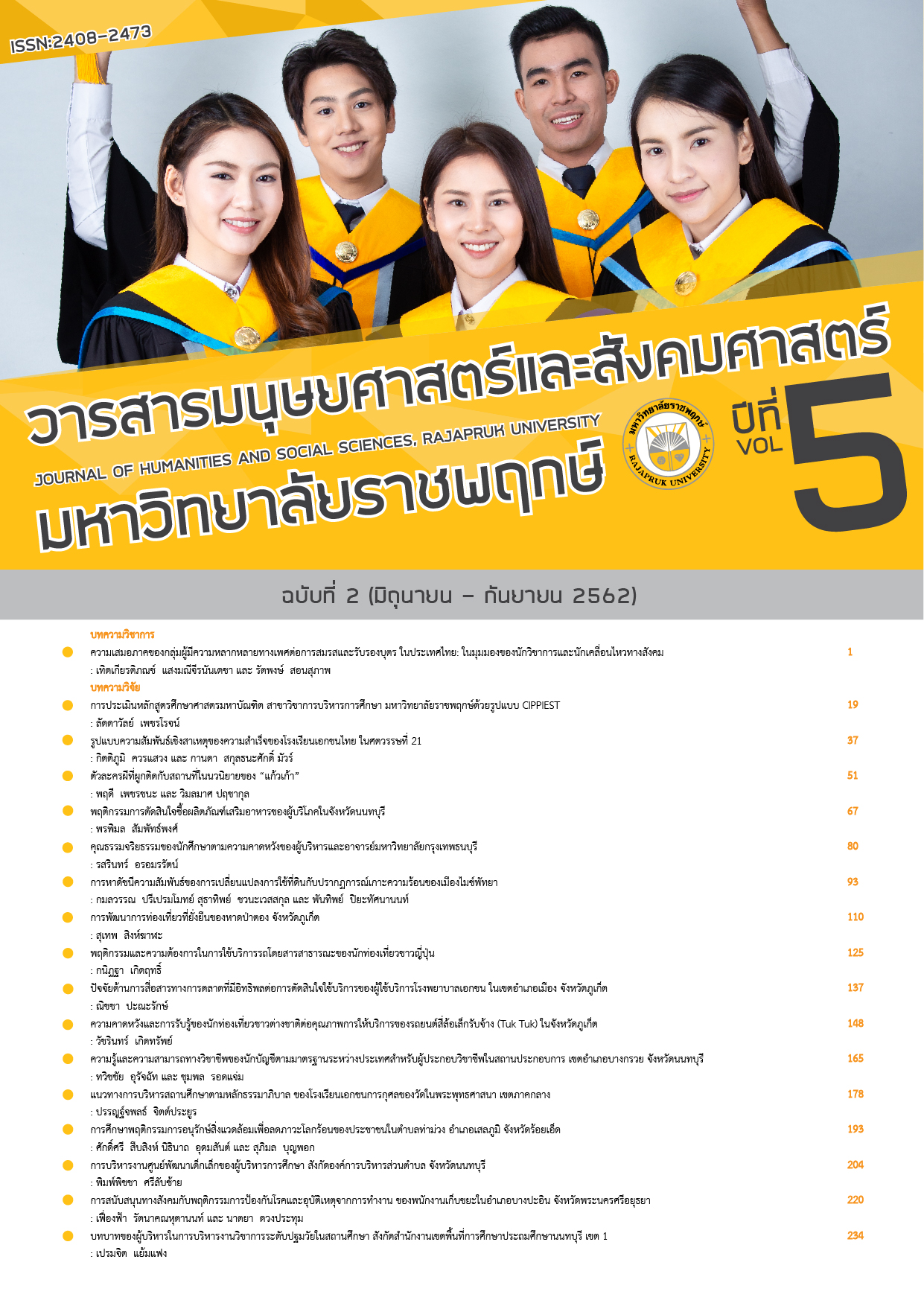Behavior and Needs in using the Public Transportation of Japanese Tourists
Main Article Content
Abstract
The objectives of the research were as following; 1) to study the behavior and the needs of service use the Public Transportation of Japanese tourists, 2) to compare the behavior and requirements of service use the Public Transportation of tourists from Japan by classified according to personal factor, 3) to study the needs of the service using the public bus service of Japanese tourists and 4) to compare the needs and requirements of service use the Public Transportation of tourists from Japan by classified according to personal factors. The samples were 400 Japanese Tourists. Collected was by questionnaire. Data was analyzed by frequency, percentage, mean, standard deviation, difference test by t-test and One-way ANOVA. From the study the behavior of Japanese tourists who used public transportation service was as follows: Japanese tourists use the service BTS/MRT/ARL most. The Japanese tourists to use services most is the time 09.31 pm. - 15.30 pm. more than 4 times per week with their family. A comparison between the behavior of the public transportation. Male and female of Japanese tourist have difference behavior when use public transportation service. Japanese tourists with different occupation and education have different behavior in using public transportation service. The need to use the public transportation of Japanese tourists. Overall, the needed at high level. The quality and safety of the service in public transport. As the traveler is the most demanding. Comparison between the demand for public transportation services of Japanese tourists with occupation found that the overall needs of each side were different.
Article Details
References
กุลธน ธนาพงศธร. (2538). ประโยชน์และบริการ. ใน เอกสารการสอนชุดวิชาการบริหารงานบุคคลหน่วยที่ 1-7, (หน้า 19). นนทบุรี: มหาวิทยาลัยสุโขทัยธรรมาธิราช.
เจนวิทย์ เชื้อสาวะถี. (2557). ภาพลักษณ์ Taxi ไทย. ค้นเมื่อ 4 เมษายน 2559, จาก http://news.voicetv.co.th/thailand/107817.html
ประชาชาติธุรกิจออนไลน์. (2558). ท่องเที่ยวมั่นใจ! รายได้ปีนี้ 2.2 ล้านล้านบาท 5 เดือนแรกต่างชาติเที่ยวไทย 12.4 ล้านคน ค้นเมื่อ 24 มีนาคม 2559, จาก https://www.prachachat.net/news_detail.php?newsid=1434369465
ผู้จัดการออนไลน์. (2559). “กสิกรไทย” คาดต่างชาติทะลักเที่ยวไทย 32 ล้านคน จี้หันเน้นคุณภาพ. ค้นเมื่อ 27 มีนาคม 2559, จาก http://www.manager.co.th/Smes/ViewNews.asp x?NewsID=9590000006048
มริษา ไกรงู. (2552). ความพึงพอใจของผู้โดยสารต่อการใช้บริการรถตู้โดยสารปรับอากาศประจำเส้นทาง กรณีศึกษา: สายกรุงเทพ–เพชรบุรี (หมายเลขเส้นทางเดินรถ 73). ปริญญาบริหารธุรกิจมหาบัณฑิต มหาวิทยาลัยกรุงเทพ.
มันนี่ฮับ. (2558). ปัญหาแท็กซี่สนามบิน กับภาพลักษณ์ของเศรษฐกิจท่องเที่ยวไทย. ค้นเมื่อ 27 มีนาคม 2559, จาก https://moneyhub.in.th/article/ปัญหาแท็กซี่สนามบิน/
วริทธิ์ พิพิธพจนการณ์. (2553). ปัจจัยที่มีผลต่ออุปสงค์การท่องเที่ยวของนักท่องเที่ยวชาวญี่ปนที่เดินมาท่องเที่ยวในประเทศไทย. สารนิพนธ สาขาวิชาเศรษฐศาสตรการจัดการ มหาวิทยาลัยศรีนครินทรวิโรฒ.
สถาบันวิจัยเพื่อการพัฒนาประเทศไทย. (2558). พลิกโฉมความปลอดภัยรถเมล์ไทย ด้วยระบบประเมินคุณภาพต่อเนื่อง. ค้นเมื่อ 4 เมษายน 2559, จาก https://tdri.or.th/2015/11/bus-road-safety/
สุภัสสรา ปัญโญรัฐโรจน์. (2561). การจัดการโลจิสติกส์สำหรับการท่องเที่ยวในจังหวัดนนทบุรี. วารสารมนุษย์ศาสตร์และสังคมศาสตร์ มหาวิทยาลัยราชพฤกษ์, 4(ฉบับเสริม): 151-161.
Department of Tourism. (2014). Tourism Statistics. Retrieved on 8th April 2016, from http://www.tourism.go.th/home/details/11/221/24710 (in Thai)
Chueasawatee J. (2014). Taxi Thailand's image. Retrieved April 4, 2016, from http://news.voicetv.co.th/thailand/107817.html (in Thai)
Kraingu, M. (2009). The satisfaction of passengers to use van service: Bangkok- Phetchaburi Route (No. 73). Master of Business Administration, Bangkok University (in Thai)
Manager Online. (2016). “Kasikornthai” expected Foreign spilled over to Thailand around 32 million people and turned the focus on quality. Retrieved on 27th March 2016 from http://www.manager.co.th/Smes/ViewNews.aspx?NewsID=9590000006048 (in Thai)
Moneyhub. (2015). The airport taxi problem with Economic Image of Thailand's Tourism. Retrieved on 27th March 2015, from https://moneyhub.in.th/article/Airporttaxiproblem/ (in Thai)
Panyorattaroj, S. (2018). Logistics Management for Tourism in Nonthaburi Province. Journal of Humanities and Social Sciences Rajapruk University, 4(Supplement): 151 – 161.
Pipitpojanakarn, V. (2010). Factors Affecting The Tourism Demand of Japanese Tourists Traveling to Thailand. Independent study Faculty of Economics, Srinakharinwirot University. (in Thai)
Prachachatonline. (2015). The Department of tourism, assured income this year 2.2 trillion Bath. After 5 month, 12.4 million foreigners visit Thailand. Retrieved on 24th March 2016 from https://www.prachachat.net/news_detail.php?newsid=1434369465 (in Thai)
Thailand Development Research Institute. (2015). Transforming Thailand bus safety by continuous quality evaluation system. Retrieved on 4th April 2016, from https://tdri.or.th/2015/11/bus-road-safety/ (in Thai)
Thanapongthorn, K. (1995). Benefits and services. in Human Resources Text book Unit 1-7, (p.19). Nonthaburi: Sukhothai Thammathirat Open University (in Thai)
Yamane, Taro. (1973). Statistics: An Introductory Analysis. 3rd ed. New York: Harper and Row Publication.

